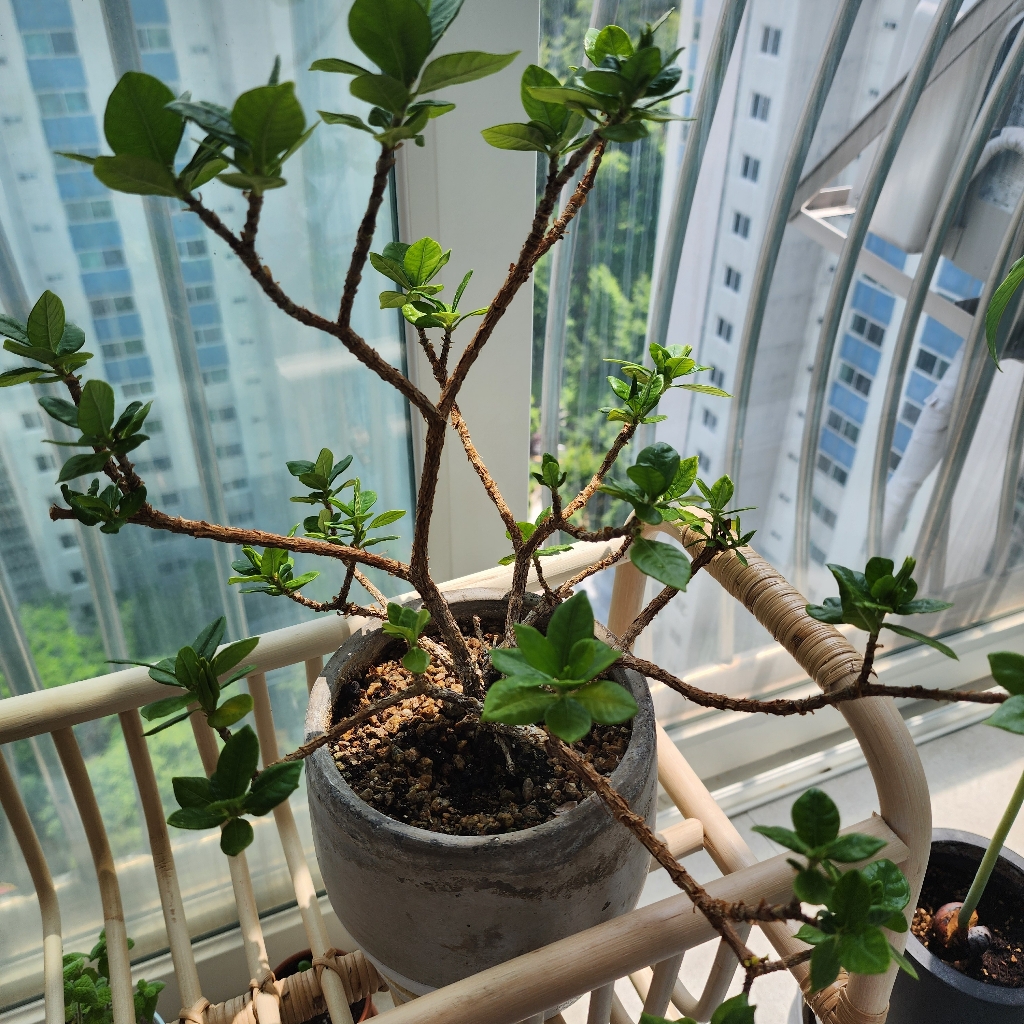How to grow and care for Gardenia jasminoides
plant care guide about watering, fertilizing, trimming, repotting, cutting, propagating Gardenia jasminoides, Danh-danh, Cape jessamine
Gardenia jasminoides 101 - Plant Care Instructions
Bright direct light
15C° ~25C°
Every 7 days
Botany Encyclopedia
Species : Gardenia jasminoides
🏝️ Habitat Conditions
It primarily inhabits Southeast and Northeast Asia. It is best not to overwinter it outdoors. It prefers a warm environment, so bringing it indoors during winter is advisable.
🪨 Soil Mix
When planting in the yard, use well-draining soil and create drainage channels to prevent water pooling. It's best to plant in soil with good drainage. A common soil mix ratio is 40% potting soil, 20% bark, 20% leaf mold, 10% perlite, and 10% humus, though this can vary based on conditions and environment. Since the plant thrives in acidic soil, it's beneficial to use blueberry-specific soil or sprinkle sulfur to slightly acidify the soil.
🌡️ Environment
Daytime temperature should be 21-25°C and nighttime temperature 15-18°C. In winter, it can withstand temperatures down to -5°C, but if it drops lower, it's best to keep it indoors. The plant prefers high humidity levels of 50-70%. To maintain this, regularly mist the plant or place a water tray nearby to increase humidity. Be cautious of pests and diseases in humid environments with poor air circulation.
☀️ Light
It is good to ensure the plant receives plenty of light. In the midday summer sun, the leaves can burn, so it's advisable to use a shade cloth or move the plant to a shaded area.
💧 Water
Water the plant when the surface soil is dry. It prefers moist soil, so keep it that way from spring to summer. During the winter dormancy period, water only after the inner soil has dried out.
🌱 Propagate
Propagation is mainly done through cuttings. For cuttings, use sterilized tools to cut 10-20 cm branches at an angle. Let them dry for 3-4 hours, then place them in soil or water for propagation. 1. For water propagation, avoid transparent containers. Place the stem in water, and once roots appear, use hydroponic fertilizer. If roots are 5-7 cm or longer, transfer to soil. 2. For soil propagation, plant deeply in soil without fertilizer. After taking cuttings, avoid exposing them to bright light. Gradually increase light exposure to help them adapt to gentle light. Maintain high humidity and keep the temperature between 20-25°C.
🪴 Repot
Repot every 1-2 years in spring due to fast growth.
💊 Fertilize
During the growing season from spring to summer, using fertilizer once while adhering to the recommended amount can promote more vigorous growth.
🌺 Flower
The flowering period is usually from June to August in summer. Maintain high humidity and provide plenty of light to encourage the plant to bloom annually with white, fragrant flowers. Over time, the flowers naturally turn yellow, which is a normal occurrence. To see fruit, cross-pollination using pollen from another plant is more successful than self-pollination. You can achieve this by artificially pollinating with a cotton swab or brush to transfer pollen to the flowers of another plant, which can result in fruit production.
water
How to water Gardenia jasminoides
How often should I water?
check Gardenia jasminoides Every 7 days if it needs water when it’s very cold (below 5℃), water less frequently
When do I need to water?
the top 2-3 inches of soil is dry
Light & Location
How much light does a Gardenia jasminoides need?

Bright direct light
Bright indirect light
Grow light
Light preference
Gardenia jasminoides likes Bright direct light, Bright indirect light, Grow light day. The brighter the space, the better this plant grows.
Check if there’s an optimal place in your house!
This plant prefers
2K ~ 20K lux to thrive!
0
20K~
2K
20K
Temperature
Houseplants
-15
15~25℃
45
Plants that grow in the wild and those that grow indoors prefer different temperatures. If you grow Gardenia jasminoides at home, make sure the temperature is 15~25℃.
Humidity
Ideal humidity
0
40~70%
100
Gardenia jasminoides prefers humidity about 40~70%. If necessary, increase humidity by misting, humidifier.
Fertilize
Collective Knowhow
When should I fertilize?
Only when your plant is healthy
How frequently should I fertilize?
1-2 times in growing season. A pinch for a small pot.
Characteristic
The taxonomic classification of Gardenia jasminoides is as follows. - Kingdom: Plantae, Phylum: Tracheophyta, Class: Magnoliopsida, Order: Gentianales, Family: Rubiaceae, Genus: Gardenia, Species: Gardenia jasminoides
| Characteristic Name | Characteristic Value |
|---|---|
| Habitat | East Asia |
| Taxonomy Name | Taxonomy Value |
|---|---|
| Phylum | Tracheophyta |
| Class | Magnoliopsida |
| Order | Gentianales |
| Family | Rubiaceae |
| Genus | Gardenia |
| Species | Gardenia jasminoides |
Is your plant sick?
Track what happened. We’ll let you know the cause and treatment shortly!





1:1 Expert Help
You’ll get professional feedback within 24 hours from an expert on our team.
feedback will include










